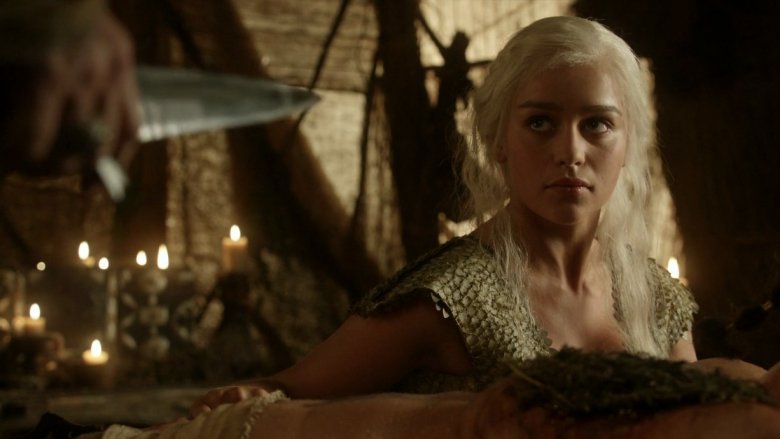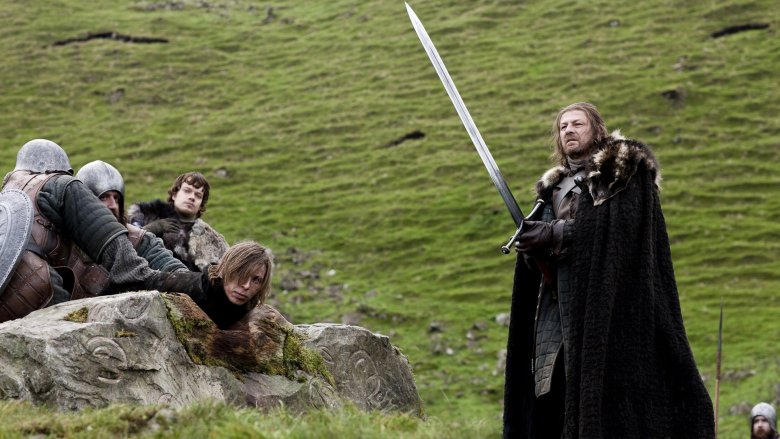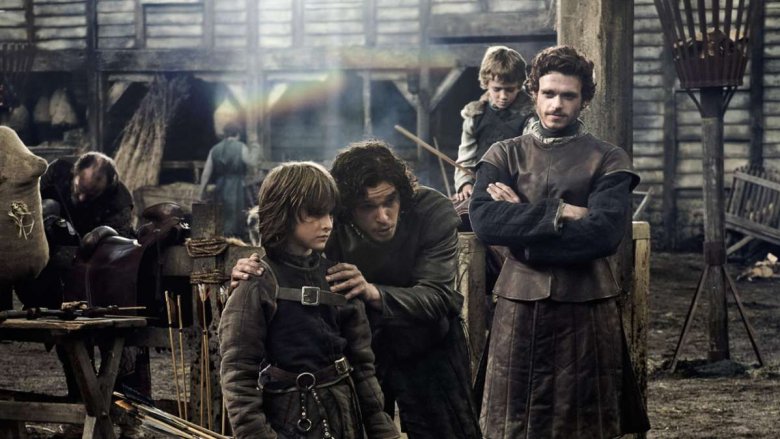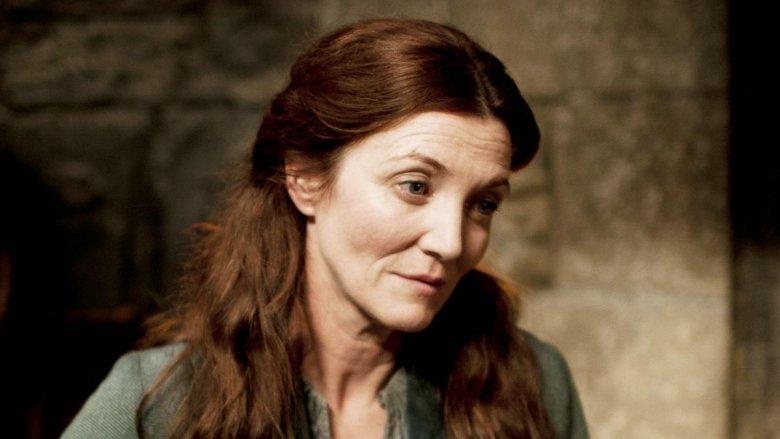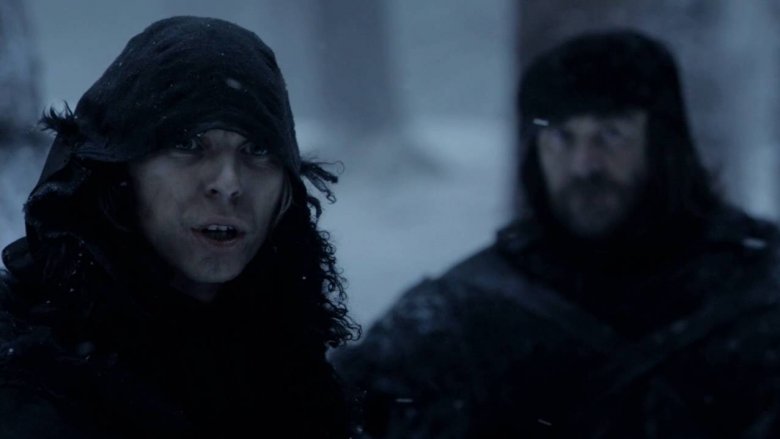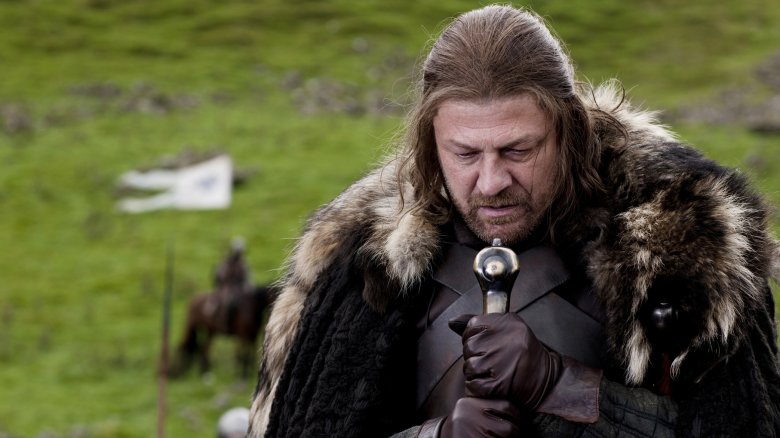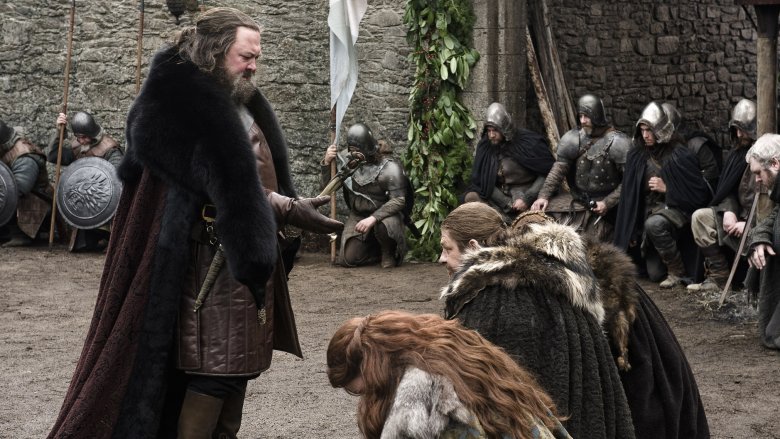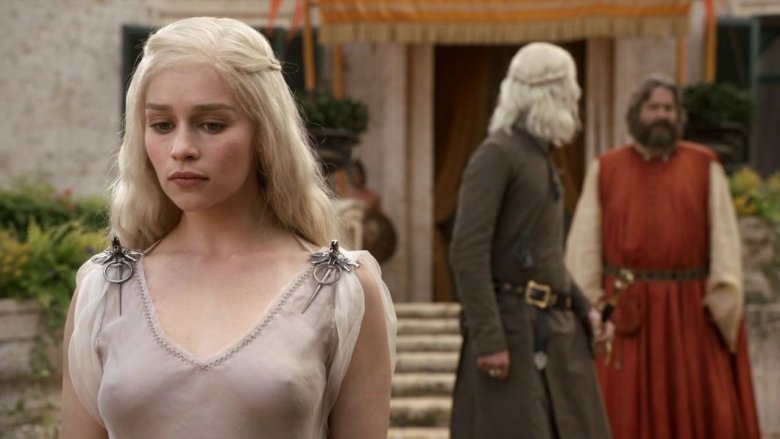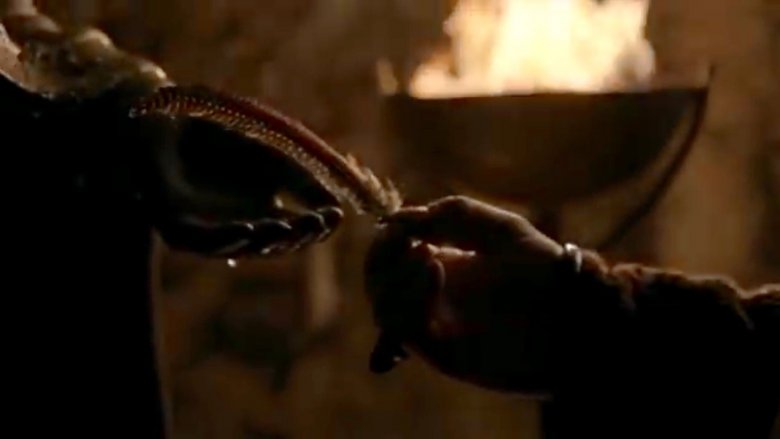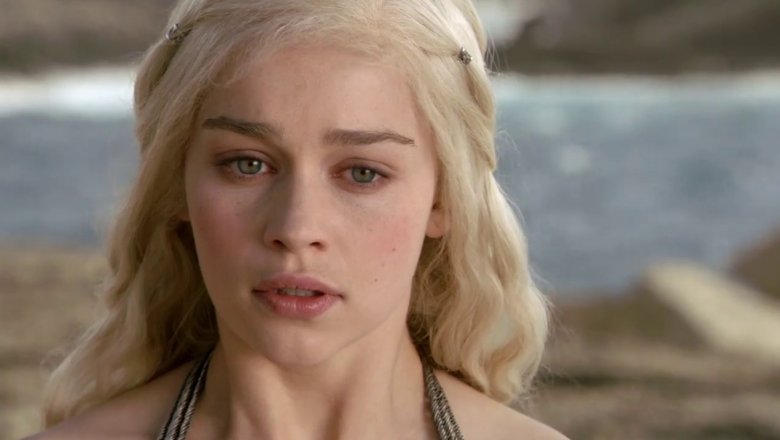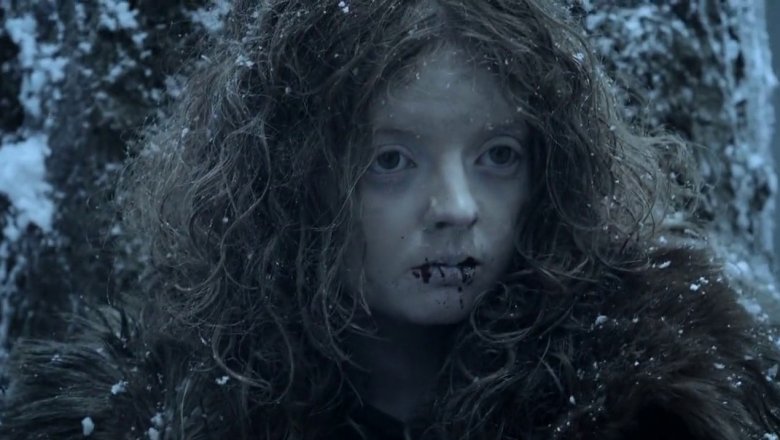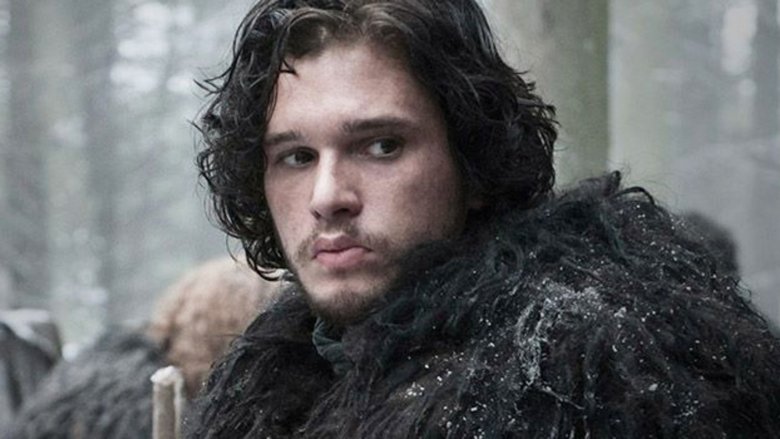The Untold Truth Of Game Of Thrones' Original Unaired Pilot
No matter how many times you've binged Game of Thrones from start to finish or churned through the various deleted scenes, bloopers, and DVD extras, there's still one major piece of footage from the show you may never get to see: the original pilot. That's right: The first episode of the series, which debuted in April 2011, wasn't the original starting point for HBO's Game of Thrones.
Two years prior to the show actually airing, executive producers D.B. Weiss and David Benioff oversaw the production of another pilot effort to adapt George R.R. Martin's A Song of Ice and Fire books, and the result was a colossal mess that had to be almost entirely redone. By the time they were finished, several key roles for the show had to be recast, certain scenes had to be rewritten for clarity's sake, and everyone involved took a big bite of humble pie in the process, as the cable network even considered scrapping the show altogether. Here's the untold truth of Game of Thrones' unaired original pilot.
Hard home
The road to making Game of Thrones' first pilot effort was a long one. Weiss and Benioff were major fans of Martin's books and approached the author about potentially adapting the series as early as 2005. The two won him over by correctly guessing who Jon Snow's mysterious mother was (Lyanna Stark, of course).
"I think with us, he understood that we didn't have to fake anything. We had become instantly and genuinely obsessed with his books to the point where we knew lots and lots about the minutiae of them — and then he asked us the question about Jon Snow's parentage," Weiss explained to Variety. "Maybe if we had gotten it wrong, he would have let us do it anyway. It was still obvious that we love this, and that we wanted to do it more than anything in the world, and that we would respect it and honor it. I think getting it right probably helped." In 2007, HBO optioned the adaption, and things finally seemed to be in motion. Shortly thereafter, though, the Writer's Guild of America strike commenced and left the project in pre-production limbo until it ended in 2008, when the cable network officially purchased the adaptation rights for Game of Thrones.
Talent pool
Weiss and Benioff penned the script for the would-be inaugural episode and, in 2009, tapped first-time TV director Tom McCarthy to take the helm of the effort. The first cast member to be announced for the show was Peter Dinklage as Tyrion Lannister — not only was he Martin's prime pick for the role, but he also had a prior working relationship with McCarthy, as he starred in the director's feature debut The Station Agent in 2003.
The earliest filming locations were also eyed in Scotland and Morocco before Belfast, Northern Ireland was confirmed as the show's central production site. Things were still a bit bumpy — shortly after an office was established, Martin announced another two-week delay in pre-production — but casting news soon followed en masse. Many of the actors who initially boarded the pilot would remain involved for the second effort, including Kit Harington as Jon Snow, Sean Bean as Eddard Stark, Mark Addy as Robert Baratheon, Sophie Turner as Sansa, Maisie Williams as Arya, Richard Madden as Robb, Isaac Hempstead-Wright as Bran, Jason Momoa as Khal Drogo, Alfie Allen as Theon Greyjoy, Lena Headey as Cersei Lannister, Nikolaj Coster-Waldau as Jaime, Jack Gleeson as Joffrey, Iain Glen as Jorah Mormont, Joseph Mawle as Uncle Benjen, Esme Bianco as Ros, Rory McCann as Sandor Clegane, Harry Lloyd as Viserys Targaryen, and more. However, there were several key characters that wouldn't make it past the failed first pilot.
Long gone
While most of the initial cast list will still be familiar to fans of Game of Thrones, there were a few key characters who would have looked very different to fans had the original pilot gone through. Jennifer Ehle, for example, was initially chosen to portray Catelyn Stark, and Martin himself mused that "she will be a wonderful Catelyn." However, after Ehle became unavailable for reshoots, she was replaced by Michelle Fairley, who redid her portion of some scenes (she's never seen with Sansa in the first episode because part of Turner's performance remained untouched in the reshoot process).
Meanwhile, Tamzin Merchant was the initial pick to star as Daenerys Targaryen, but she also decided not to return for the reshoot, which opened the Mother of Dragons role up to Emilia Clarke. Ian McNeice was initially on tap to play Illyrio Mopatis, who helps Viserys sell his sister to Khal Drogo, but he was later replaced by Roger Allam. Richard Ridings originally signed on as the Night's Watch ranger Gared but was replaced in the second pilot by Dermot Keaney. And Jamie Campbell Bower also appeared to be ready to improve upon his already-impressive fantasy book-to-screen credentials as Waymar Royce, but the role later went to Rob Ostlere.
Crash and burn
After the pilot was finally produced, it didn't take long for the co-creators to realize it was inadequate, and the responsibility for those misgivings laid squarely with them. As Benioff would later admit to Variety, "we got everything wrong on a very basic level with the writing of it." He and Weiss screened the episode for some friends, including screenwriter Craig Mazin, and said, "Watching them watch the pilot was a deeply humiliating, painful experience, because these are very smart individuals, and it just clearly wasn't working for any of them on a very basic level."
Mazin reportedly told them right away, "You guys have a massive problem." One of the major issues he and others pointed out with the initial pilot was the fact that they couldn't figure out why Jaime would push Bran from the window at the end of the episode. "Jaime is lying with his sister, Cersei, and none of [our friends] realized that Jaime and Cersei were brother and sister, which is a major, major plot point that we had somehow failed to establish," Benioff remembered. The network brass reportedly warred over whether to even fund a second try, but HBO confirmed that it would greenlight a 10-episode first season for the series, and the process of re-casting those key characters got underway.
Good save
Although HBO was still willing to fork over the cash to produce a full first season of Game of Thrones, the show's producers knew they had to bring their A-game to the new shoot. Benioff told Variety, "That first year felt very probationary. It was like, all right, these guys are probably not very good at this. Let's see what they can do. We've already sunk a lot of money into this pilot. Might as well get one season out of it." The two felt that they'd ironed out some of the kinks that sunk the first attempt, however, and they brought in director Tim Van Patten, who was already on board for the second episode, to take McCarthy's place in 2011.
Weiss said he learned from the first attempt "how information needs to flow effectively amongst a group of people," and they needed to "make decisions more quickly and how to streamline that process." Indeed, when they put the finishing touches on the new pilot and premiered it, they'd won over one of their earliest detractors in Craig Mazin. He later told the two that he went in with muted expectations for round two but walked away amazed, saying, "I very specifically remember walking out in between and you were there, and I said to you, 'That is the biggest rescue in Hollywood history,' because it wasn't just that you had saved something bad and turned it really good."
Taking credit
Tim Van Patten was already a venerated small screen director thanks to his work on The Sopranos, The Pacific, and more. Meanwhile, Thomas McCarthy was merely given a "consulting producer" credit and never returned to the series.
If that seems a bit harsh, McCarthy later revealed that it was his own tight filming schedule on a subsequent movie that interfered with his return to the Game of Thrones pilot — along with his disinterest in TV. "I did a lot of the casting. I think we did some good work. But they've had to reshoot and rethink so much of it since I left, and I've had no involvement in that," he told The AV Club. "I turned in an early cut, and they had to recast. [...] They're taking on this huge book, and they rethought how to get into it and how to set it up. They had to change some locations, and they did quite a bit of work on it since I left. I'd like to think I had some impact on it, but I don't think much of that is mine anymore." McCarthy also said he had no interest in returning to the show because the process "didn't feel like a director's medium," and he had only done it in between other projects as a "challenge."
Cutting a cameo
For those fans of A Song of Ice and Fire who held out hope for the author to make a cameo in Game of Thrones, the good news is that he did shoot one. The bad news is that it was part of the original pilot footage that's gathering dust in the archives, and he refused to return to the set to film another one in the show's final season. Martin revealed to Empire Online in 2012, "I made a cameo in the original pilot, which was filmed in Morocco. I was a Pentoshi nobleman, and one of the guests at Dany's wedding to Khal Drogo. However, subsequently we recast the part of Dany, so the entire Morocco wedding sequence was cut, and my brilliant cameo was left on the cutting room floor."
In early 2019, Martin told Entertainment Weekly that he was invited by Weiss and Benioff to try again for an unspecified season 8 cameo, but he was simply too busy writing The Winds of Winter to bother traveling for another chance at some screen time. "I didn't think just for the sake of a cameo I could take the time to return to Belfast," he explained. Martin has joked, however, that he might eventually like to see his head on a stake. Dare to dream.
Comparing scripts
Over the years, there've been several efforts to bring the lost Game of Thrones pilot script to light, and in 2019, a Huffington Post reporter finally managed to get his hands on an official copy that George R.R. Martin had donated to Texas A&M's library alongside some of his own manuscripts. Upon investigating the writing, the journalist discovered some significant differences between what Game of Thrones fans would see onscreen and what was originally written.
For one thing, Cersei finds and steals the feather Robert Baratheon places on Lyanna's crypt and instructs a handmaid to burn it. Prior to that Game of Thrones season 8 teaser which shows Sansa finding the remnant in the crypt, the feather had been long forgotten after Sansa looked at it in season 5. Considering how attuned Cersei was to the fact that her husband never got over the loss of Lyanna, and the fact that there was little love lost between herself and Robert Baratheon, that gesture of jealousy may have been confusing.
Make it consensual
Another key difference HuffPo discovered between the original manuscript and what played out onscreen was the way the early relationship between Khal Drogo and Daenerys Targaryen played out. In the show, Dany is objectified by Viserys and the Khal and attempts to resist Khal's advances before being forced to have sex with him after they are married.
In Martin's book, the encounter was a bit more consensual, and the original script would've more closely aligned with that version of events. In the dialogue for the unearthed screenplay, Daenerys even audibly agrees to sleeping with Khal Drogo, rather than suffering through his violence the way audiences would later see. Obviously, the earlier draft would've been less triggering, and it may have quickened the sense of partnership she and Khal would later develop as she embraced her role as the new Khaleesi. Instead, Daenerys' journey started on a darker path.
Other key differences
Another key difference that exists between the unaired pilot script Huffington Post got their hands on and what actually aired is probably the confusion surrounding Cersei and Jaime's relationship that the producers later identified as a problem. In the written scene, she's shown objecting to sex with him before Bran arrives in the window, instead of seeing him and then trying to save face. Without it being obvious that Bran had walked in on something he wasn't supposed to see, Jaime's motive for attempting to kill him would have been unclear.
Meanwhile, the White Walkers also talk to each other in their own unique language in the first iteration of the episode, and Jaime even taunts Ned over the death of his brother and father in the original script. Perhaps most significantly, Catelyn is much more amiable to Ned and Sansa moving to King's Landing and even hoped her daughter could become Joffrey's queen. And Jon Snow isn't quite as ostracized by his pseudo mother Catelyn in the earlier version of their dinner scene.
Blackmail
Game of Thrones fans may be eager to see what footage was too bad to make it to air, but so far, no plans to release the footage are in place — unless Kit Harington does something to upset the producers, at least.
Harington told The Guardian that he understands why Game of Thrones' first pilot was trashed because "They made a lot of mistakes. It didn't look right, didn't feel right, had nothing different about it." He in particular didn't bear the same visage as Jon Snow and didn't sport the same hairstyle or beard that have become the character's signature look. According to him, that's enough fodder for the producers to hold over his head — he definitely does not want the reels to be released. "They say if I ever piss them off too much, they'll release it on YouTube," he told the publication. "Every now and then, they send me a screengrab, just as a threat." So now you know. If that long-lost Game of Thrones pilot does ever find its way online, it's because the King in the North got on someone's bad side and brought winter down on himself. For the watch.
